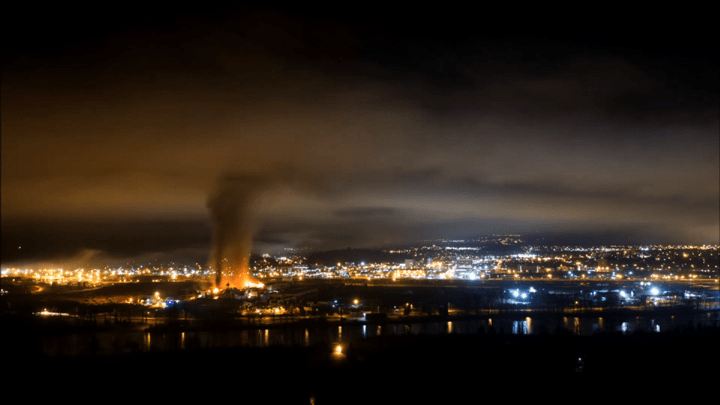WATCH ABOVE: A preview for 16×9’s investigation “Deadly Mills”

Mid-January 2012 was not a good time to be working in the Babine Sawmill in Burns Lake. Temperatures dropped to minus 40 degrees Celsius. Water pipes froze. Heaters were malfunctioning in the basement; the dust collection system had been unreliable for months.
“You couldn’t see across the mill, that’s how bad the dust levels were,” said millworker Ryan Clay. “Even with the fans going full blast, the dust was just horrendous.”
At eight o’clock on the night of January 20, the fire alarm sounded. A saw-filer in the mill felt the floor lift beneath his feet. Then he was engulfed in flames. The plant watchman was hit by a fireball. A yardman who was just outside saw the roof of the mill blow off, followed by a fireball. Two workers were killed. One of them, Robert Luggi, had texted his wife moments before to “pray for me” as he was going to investigate something in the mill. Luggi was cremated in the flames.
WATCH BELOW: An extended interview with Maureen Luggi. Her husband was one of two people who died in the Babine Sawmill explosion.
It was the first known explosion of this magnitude, ever, in Canada’s sawmills industry. A subsequent investigation by a government agency found it to be a “preventable accident” because “management had known for some time that the dust collection system was undersized for this type of operation.” Wood waste was not adequately removed. Supervisors were not supervising. The employer should have known from previous fires, said WorkSafeBC, that accumulated dust was dangerous.
READ MORE: Mill explosion was preventable, says WorkSafeBC
Then, incredibly, only three months later, it happened again—this time at the Lakeland Sawmill in Prince George, B.C. Another fire, another explosion, another two fatalities. Once again, accumulated wood dust was identified as the likely fuel. The industry went into shock—that this could happen not once, but twice, in such a brief time, was inexplicable.
The mill owners hung their heads—“devastated” said one headline—and said they couldn’t have known. Explosive wood dust, they said, was a new and unforeseen hazard. Sure, small fires were not uncommon on the industry. But there’s never been anything like this. Besides, government inspectors had never alerted them to the risk of dust explosions, they said.
READ MORE: How sawmill dust explosions happen
Ultimately, lawyers from the B.C. Criminal Justice Branch agreed with the companies, saying there would be no prosecutions, because the companies would likely win in court with a due diligence defence. Further, WorkSafeBC, which had urged the laying of regulatory charges, was found to have conducted its investigations improperly. Investigators hadn’t followed due process in gathering evidence, and questioning managers.
Some workers cried foul. Indeed, they said, they had warned management time and time again about dust levels in the plant.
“I can probably name eight or 10 people, I was telling them, we’re going to blow up,” said Bruce Germyn, still suffering from post-traumatic stress more than two years later.
“I only wish that people listened to us.”
It wasn’t only workers who sensed disaster. The Prince George fire department had warned the Lakeland plant about the dust accumulations and the need for a fire safety plan. “I know there was a hazard,” one officer with the Prince George Fire and Rescue Service would say later. “Did I know how bad it was? I was naive like probably the rest of the whole industry.”
WATCH BELOW: An extended interview with Greg Chayko. He estimates he was standing about 100 feet from ‘ground zero’ when the Lakeland mill in Prince George, B.C. exploded in April, 2012.
There were other premonitions. Two months before the Lakeland blast, WorkSafeBC received an anonymous phone call complaining about a pileup of sawdust on the mills horizontal surfaces, and fearing Lakeland would turn into “the next Burns Lake sawmill.” And 11 days before the blast, an engineer with a company that made industrial vacuum systems had inspected the plant, and warned of the risk of an explosion. Neither warning got any traction.
Occupational health and safety regulations warn that a layer of wood dust as thin of a dime can, if dispersed, cause an explosion.
A coroner’s inquest scheduled for next March in Prince George will look into the four deaths, and attempt to determine who, and what, went wrong. But some of the families of those injured or killed believe that’s not going far enough: they want a public inquiry that will name names and assess blame.
“No one,” says widow Maureen Luggi, “is going to shove this under the carpet and say this is the cost of doing business, because it’s unacceptable for our families.”
The Babine mill has been rebuilt and is back in business. The Lakeland mill expects to resume production soon.
UPDATE: Last May, a coroner’s jury in Prince George found that the explosion that killed two workers at the Lakeland mill was an accident.
WATCH: The survivors of the two 2012 deadly sawmill explosions in British Columbia are still waiting for what they call justice. Ryan Clay is a survivor of the Babine sawmill explosion and gives us an update.
TIMELINE
February 23, 2011
A fire and small explosion occur at the Babine Sawmill in Burns Lake, B.C. An investigation blames dry dust from beetle-killed wood.
December 28, 2011
Air sample testing shows a problem in the mill—the level of dust in the air exceeds regulations. The mill is cited for a violation of safety rules.
January 3, 2012
Babine Sawmill managers say they are looking into outfitting their workers with dust masks.
January 20, 2012
A massive explosion destroys the mill, killing two workers and injuring 20.
February 3, 2012
An anonymous caller contacts WorkSafeBC, and warns about excessive dust buildup in the Lakeland Sawmill in Prince George, B.C. He says he is worried about it “turning into the next Burns Lake sawmill.” An investigator visits the mill. No violation order is issued.
April 12, 2012
A representative of an industrial vacuum manufacturer visits Lakeland, takes photographs and issues a warning about the risk of an explosion because of dust buildup.
April 23, 2012
A massive explosion, similar to the one that destroyed Babine, levels the Lakeland mill killing two workers and injuring 22. The president of the company that owns the mill, Greg Stewart, says he is “eternally sorry.”
October, 2012
Major forest companies create a “dust audit” to increase safety at their sawmills in British Columbia. The audits are voluntary.
January 10, 2014
After reviewing an investigation into the Babine explosion by WorkSafeBC, the Criminal Justice Branch of the B.C. Ministry of Justice says there was “no substantial likelihood of conviction” on regulatory charges. Therefore, there would be no prosecution.
March 6, 2014
B.C. Premier Christy Clark says her government will not hold a public inquiry into the two explosions, despite the appeals of workers and families of the dead and injured.
April 3, 2014
Babine Sawmill owners are hit with an “administrative penalty” of nearly $1 million—the maximum allowed under government rules. Later, the company says it will appeal the fine.
April 14, 2014
The Criminal Justice Branch announces that no regulatory charges will be laid against the owners of the Lakeland Mill, for essentially the same reasons as for not charging the Babine owners. The CJB says WorkSafeBC investigators did not follow legal procedures, and the company would likely be able to succeed with a defence of due diligence.
July 29, 2014
WorkSafeBC fines Lakeland Mill owners $724,000 in administrative penalties.
16×9’s “Deadly Mills” airs this Saturday at 7pm.
- What is a halal mortgage? How interest-free home financing works in Canada
- Ontario doctors offer solutions to help address shortage of family physicians
- Capital gains changes are ‘really fair,’ Freeland says, as doctors cry foul
- Budget 2024 failed to spark ‘political reboot’ for Liberals, polling suggests





Comments